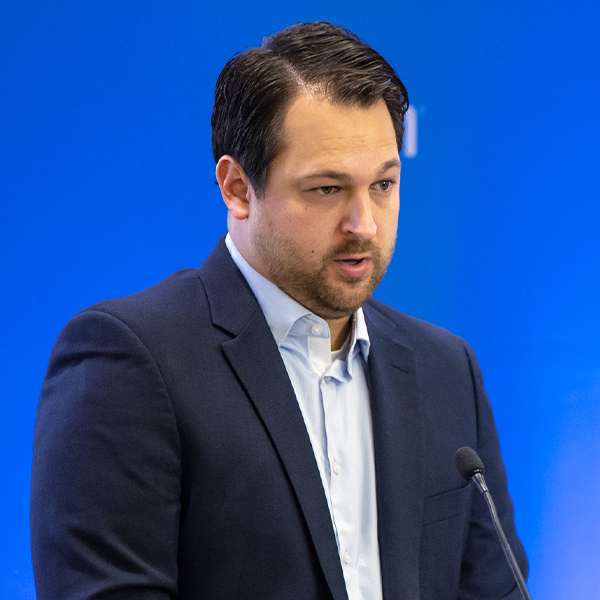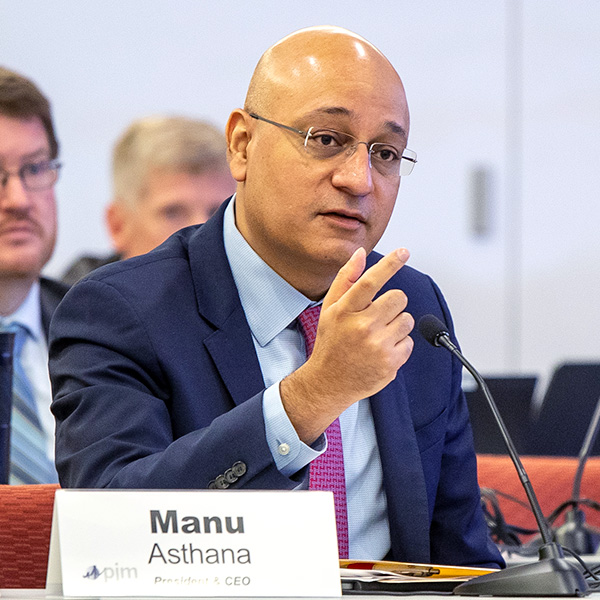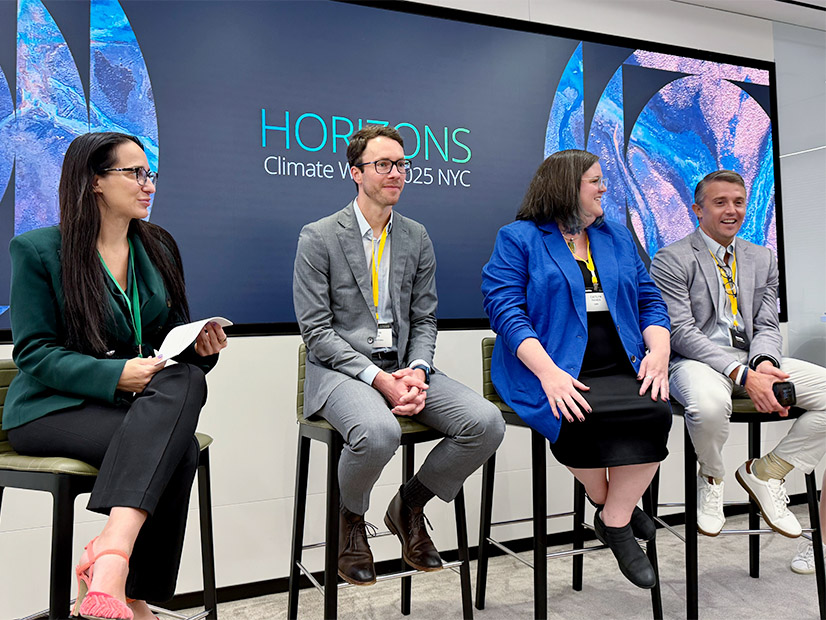Stakeholders Endorse Widened Provisional Interconnection Service
PJM’s Markets and Reliability Committee endorsed by acclamation a set of manual revisions to expand when a new resource could be granted provisional interconnection service to allow for early operation when it becomes capable of injecting a portion of its output while its network upgrades still are under way.
PJM Director of Interconnection Planning Donnie Bielak said the RTO brought the changes against a backdrop of an increasing number of emergency procedures with the objective of making as many resources as possible available to dispatchers in the coming years.
The Planning Committee endorsed the quick fix proposal Sept. 9, including an issue charge to explore creating a process for PJM to proactively identify resources that could take advantage of provisional service. (See PJM Stakeholders Endorse Expansion of Provisional Interconnection Service.)
Interim deliverability studies are conducted to determine if resources that have been completed, but are awaiting completion of assigned network upgrades, can operate without triggering transmission violations.
Under current rules, if a unit cannot reliably inject its full output, it is denied provisional service. The proposal would create a second round of analysis to determine if a resource not capable of full operations could provide output at a fraction of its nameplate. If so, an operational guide would be produced to inform dispatchers how the unit could be operated. Project developers must request, and pay, for PJM to conduct the studies, which would not be changed by the proposal.
Bielak said PJM is processing studies for the 2026/27 delivery year and is planning to present the results in the next few weeks. If the change is approved, it will be applied to the results and no further action is needed from developers who already have sought provisional service for that year.
Stakeholders debated an amendment PJM proposed to add the phrase “consistent with PJM’s governing documents” to language outlining the information the RTO would publish about individual requests for interim deliverability studies, including the location and provisional output desired. After a discussion with stakeholders, PJM revised the amendment to instead state that applicants “agree to waive their rights to confidential treatment of such requests” and agree to the publishing of that information.
Proponents of requiring the disclosures argued transparency is needed around the requests to ensure applicants would not have insider information about the resources likely to be in operation months before other market participants become aware.
Independent Market Monitor Joe Bowring said the proposal is a great step forward on PJM’s part but contended that the resource owner should be obligated to perform when dispatched by PJM. Without such a requirement, the RTO could not rely on any possible reliability benefit from provisional resources.
Committee Approves Changes to DR Participation in Regulation Market
Stakeholders endorsed a proposal to allow demand response resources to enroll to provide regulation-only service when there are energy injections at the point of interconnection. (See “PJM Reviews Proposal on Regulation Resources at NEM Sites,” PJM MRC/MC Briefs: Aug. 20, 2025.)
The changes would allow a DR resource to participate in the regulation market when there is no load or a net injection at its POI with the consent of its relevant electric distribution company memorialized in a net energy metering agreement.
Intelligent Generation CEO Jay Marhoefer said the proposal would restore a mode of DR participation that was lost in previous FERC orders on the regulation market.
During the July 9 Market Implementation Committee meeting, he said some EDCs changed their tariffs in a manner that inadvertently prevented behind-the-meter storage from participating in the regulation market while injecting. (See “Stakeholders Endorse Changes to Storage Participation in Regulation Market,” PJM MIC Briefs: July 9, 2025.)
Bowring said advancing one element of PJM’s Order 2222 compliance filing would provide special treatment for one class of market participants and open the door for others to ask for expedited treatment for their preferred components.
“Clearly the FERC thought it was reasonable to do this, but in 2029,” he said.
Stakeholders Vote for Cost Allocation for DOE Emergency Orders
The MRC and Members Committee endorsed a proposal to define how PJM would determine how to allocate the costs associated with operating generators under a DOE emergency order. (See PJM Stakeholders to Examine Rules for Future DOE Emergency Orders.)
For orders addressing an RTO-wide resource adequacy issue, PJM would use a pro forma cost allocation that splits the costs a resource owner incurs under the emergency order across all RTO load based on each entity’s share of the monthly unforced capacity obligation. The pro forma approach would be used only when resource owners and PJM agree to use the deactivation avoidable cost credit (DACC) compensation model.
If the RA concern affects specific regions, PJM would initiate an “abbreviated stakeholder consultation” with the goal of drafting Reliability Assurance Agreement revisions addressing cost allocation. The process would pick up where the PJM DOE 202(c) Cost Allocation Senior Task Force left off on identifying recommended approaches for the RTO’s Board of Managers to consider.
If there is an emergency order unrelated to RA, PJM would initiate a Critical Issue Fast Path (CIFP) process, similar to how it proceeded after the U.S. Department of Energy ordered Constellation Energy and PJM to keep the Eddystone Generation Station outside Philadelphia online past its scheduled deactivation at the end of May. (See FERC Approves Cost Allocation for Eddystone Emergency Order.)
The abbreviated stakeholder consultation would be considered a workshop under a new section to be added to Manual 34: PJM Stakeholder Process, with voting at the MC. The pro forma cost allocation would be added to the RAA under Section 7.2A Responsibility to Pay 202(c) Charge.
Denise Foster Cronin, EKPC’s vice president of federal and RTO regulatory affairs, said she is glad PJM adopted a wider perspective on how it could proceed under different scenarios, but argued the proposal remains flawed without any way for PJM to determine the cause of an RA emergency order without direction from DOE. She said the department is unlikely to delve into the drivers of RA needs.
Sophia Dossin, of Middle River Power, said the RTO should think about how to proceed if there is disagreement between PJM and stakeholders about whether to move ahead with the pro forma.
Phil Sussler, of the Maryland Office of People’s Counsel, argued stakeholders should have an opportunity to gain more insight into what costs can be recovered under the DACC methodology. He said units whose deactivations are being deferred are more likely to be older and run into unexpected problems that substantially increase costs. Consumer advocates protested PJM’s cost allocation filing for Eddystone, arguing that the compensation should be subject to FERC oversight rather than a bilateral agreement between PJM and the resource owner.
Responding to a stakeholder question, PJM’s Lisa Morelli said the costs to keep Eddystone online in June were covered by the revenues it received in PJM’s markets.
Regulation Market Manual Revisions Approved
The committee endorsed by acclamation a revision to Manual 11: Energy & Ancillary Services Market Operations to reflect the adoption of a tracking metric for the amount of regulation a resource should be providing. The change was included in the first phase of PJM’s redesign of the regulation market; however, language detailing the calculation of lost opportunity cost credits did not reflect the tracking regulation set point. PJM’s Brian Chmielewski said the changes are to be rolled out at the beginning of October. (See “Update on Regulation Market Design,” PJM OC Briefs: April 3, 2025.)
Members Committee
Stakeholders Endorse Revisions to CIR Transfer Filing
PJM’s Members Committee endorsed a set of revisions to a proposal to rework how capacity interconnection rights (CIRs) can be transferred from a deactivating resource to a replacement following FERC’s rejection of the original tariff changes (ER25-1128). (See PJM Preparing Alterations to Rejected CIR Transfer Proposal.)
The changes to the proposal center on two exemptions from the commercial operational date requirements for the replacement resource — one for resource types known for long development timelines and a one-time allowance for an indefinite COD delay. In its Aug. 8 denial, the commission found that allowing developers deferrals that could last years could open the door for owners to withhold CIRs by tying them up in theoretical planned resources.
The new COD requirement would mandate the replacement unit be in service by the greater of four years from the submission of the replacement generation application or three years from the deactivation date of the original resource. An amendment offered by Vistra added a requirement that the resource be online within three years of its planned in-service date and reserves the right for a developer to seek a FERC waiver from the COD requirements.
Vistra’s Erik Heinle said the change provides room for PJM and developers to negotiate the milestones.
PJM’s Jason Shoemaker said staff designed the revisions around the Reliability Resource Initiative (RRI), a one-time window PJM opened to allow 51 resources to have their interconnection studies processed under Transition Cycle 2. Like the CIR transfer proposal, RRI was intended to allow resources likely able to come quickly into service to have their interconnection process expedited.
The larger proposal aims to speed the process for studying whether a replacement resource requires network upgrades and offer an interconnection agreement within nine months of a request to transfer CIRs. A resource would be permitted to pursue the expedited process even if minor network upgrades are identified, and a categorical prohibition on storage resources would be eliminated. (See PJM Stakeholders Endorse Coalition Proposal on CIR Transfers.)
Discussion with Board Members on Large Load Growth
The Board of Managers discussed with stakeholders an ongoing CIFP process addressing large load growth, continuing a standing item on the MC agenda that board Chair David Mills sought in an effort to improve the transparency and accessibility of the body.
Opening the conversation, Mills said much of the CIFP meetings thus far have focused on the RTO’s non-capacity backed load (NCBL) and bring-your-own generation proposals, but many of the comments submitted at the onset of the process focused on the load forecast and the need to ensure understanding of the scale of the problem. He questioned how the membership prioritizes improving the load forecast relative to solutions focused on serving large loads.
Asthana said PJM has removed NCBL from its CIFP proposal based on opposition from much of the membership. Materials for the Oct. 1 CIFP meeting say PJM is shifting the focus to a price-responsive demand model similar to a voluntary NCBL model and a parallel expedited interconnection queue.
Heinle said the load forecast will dictate the range of solutions stakeholders should focus on, scaling to the size of the problem, and recommended that PJM integrate a “ground-up” perspective on the amount of data center load expected in the region. He said there seems to be an assumption that every data center load is coming to PJM, even while that industry sees many of the same supply chain issues plaguing the electric industry.
Greg Poulos, executive director of the Consumer Advocates of the PJM States, said this is one of the biggest discussion points stakeholders face, with load growth expected in the next five to seven years exceeding the total load served by CAISO. If those estimates are accurate, he said he’s not aware of any changes PJM can make to bring on sufficient generation in time.
Exelon’s Alex Stern said the load forecast is an important data point but is one of many the states and utilities use to guide their decisions around ensuring load is served. He said there has been a great deal of work done already at the Load Analysis Subcommittee to improve the transparency of the data presented there, as well as on the large load adjustment submission process.




